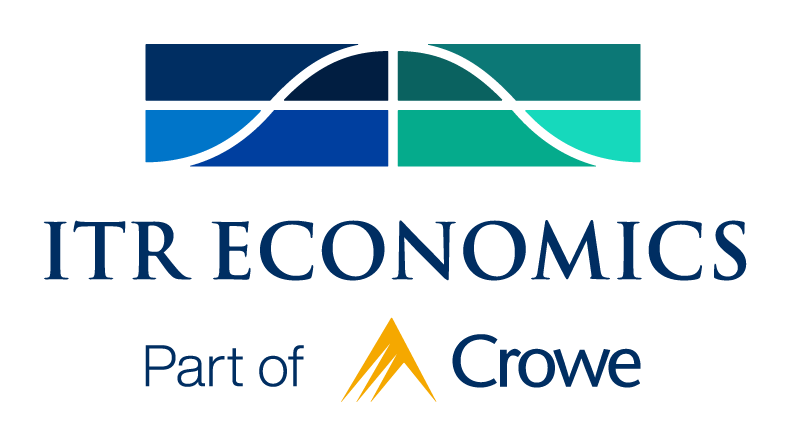July 22, 2024
- Home
- portfolio
- TrendsTalk
- July 22, 2024
OVERCOMING CHALLENGES AND FINDING OPPORTUNITIES WITH SPECIAL GUEST RYAN TANSOM
This week on TrendsTalk, ITR Economist Taylor St. Germain is joined by Independence by Design Founder Ryan Tansom. They discuss Ryan’s exciting new business, the challenges business leaders face both in this decade and in the 2030s, and offer advice for capitalizing on the opportunities, despite those challenges, ahead.

MEET YOUR HOST
Taylor St. Germain
As an experienced economist, Taylor St. Germain provides consulting services for small businesses, trade associations, and Fortune 500 companies across a spectrum of industries. His dynamic personality and extensive knowledge of economic trends and their business relevance are highly valued by clients and colleagues alike.
“Join me on the TrendsTalk podcast to explore the world of economics. Episodes offer insightful discussion and expert interviews. We cover relevant economic concepts in an accessible way. Whether you are a curious layperson or an industry professional, TrendsTalk is your go-to source for thought-provoking analysis and a deeper understanding of the economic forces shaping our world.”
Key Episode Takeaways
- 0:10 – Introducing Ryan Tansom
- 2:52 – Ryan’s relationship with ITR Economics over the years
- 6:27 – Three steps of the Independence by Design framework
- 9:08 – Challenges business owners face in the post-COVID era
- 12:11 – Preparing for the 2030s depression
- 18:53 – Current business trends and advice for capitalizing on opportunities
The below transcript is a literal translation of the podcast audio that has been machine generated by Notta.
Taylor St. Germain:
Hi everyone, my name is Taylor St. Germain with ITR Economics and welcome to this episode of TrendsTalk. Another special episode of Trends Talk, we’re joined by Ryan Tansom on this episode. Ryan played a pivotal role in reviving his family’s 21 million dollar business and facilitating an eight figure sale to a competitor in 2014.
He leveraged his experience to find multiple companies and create the independence by design framework. And that’s a business owner’s guide to personal clarity, playing the game and maximizing independence.
Ryan’s also been involved in numerous transactions and is a sought-after speaker at industry conferences and CEO masterminds. And this includes Vistage Worldwide and Entrepreneurs Organization. Additionally, Ryan’s an expert podcaster.
He’s been podcasting for over eight years. I hope you enjoy my conversation with Ryan and we’ll be back with you at the end. Ryan, thanks so much for joining us on Trends Talk today. We appreciate it.
Ryan Tansom:
Thanks Taylor. Excited to be here, man.
Taylor St. Germain:
Great, I was hoping you could start off with giving us a little bit of your background and telling us what you do and more about your business.
Ryan Tansom:
My business is Independence by Design, and it’s an owner education and coaching program. And it started off in the origin story at which I will be succinct with Taylor, but it started with the family business.
So my dad had a family business that he grew from zero to 20 million. I’ve worked in another business my whole life, joined in the business, and we had a bunch of challenges then. 2009, turned the whole business around, and then 2014, we sold the company. Eight figures sale, paid 53% in taxes, had to gut the company to sell it, devastating on a lot of different fronts. And I spent 10 years trying to figure out, honestly, what would we have done differently?
And I’ve had three different companies, Taylor, since then, service businesses. And I’ve had a podcast that I’ve been doing for eight years. I’m just relaunching the new brand. And it really just helped me understand that ownership thinking of like, what’s the cashflow equity valuation that we need, and what’s the trade -off between reinvesting and distributions, so we can have the independence of time and money that owner operators want.So they’re kind of like big picture, ate glass at the family business, tried a bunch of stuff to figure out what I learned, and then created a program to help others.
Taylor St. Germain:
Can you tell me a little bit more about how you came across ITR economics, how you’ve engaged with us in the past? What’s your relationship with ITR?
Ryan Tansom:
Well, it’s funny because it goes back actually towards the family business. I was in Vistage. So my father and I were both in Vistage and we were doing, you know, we had 115 employees. We were flying blind and we joined Vistage when we had lost a bunch.
We lost almost a million bucks in 2009 and turned the whole business around and joined Vistage started to understand what EOS was back then and ITR and like honestly was just drinking through a fire hose, Taylor.
And so I ended up becoming friends with quite a few Vistage chairs back then. Brian Davis was my chair and I’ve spoken to his group. And so honestly, after starting the podcast and then learning about valuations and learning about finance and getting deep into the three statement model and honestly, like my whole passion, Taylor is like, I want to wake up and I need to understand how to make decisions so I can have as much freedom as I humanly possibly can.
That’s why a lot of owners make, I think, make the take all the risks. And once that’s kind of what led me to finance of understanding the trade offs of all my decisions. But then I’m like, well, when I just happens and then there’s the meltdown.
So then I ended up getting into like geeking out on monetary policy and like all these like really deep topics. And so after I started becoming a Vistage chair, I stumbled across ITR. I think it was Brian and Alan that both spoke at one of the summits.
And I reached out with the podcast and I think it was Brian on the podcast or it was Alan first and then and Brian and I are now doing the quarterly economic updates. And it’s about seeing the future. So that way you don’t just make stuff up every day as a business owner.
Taylor St. Germain:
Yeah. Yeah. We still hear a lot of the gut feel, right? Making decisions based off the gut feel, and I think that’s where we both come in, right? Please stop doing that. There’s a lot of resources you have out there, so we’re steering straight rather than operating on that gut feel.
Ryan Tansom:
Oh man, I mean, and it’s the gut feel, which is so interesting because like, I think it’s the macro picture of like, people have like, like we, like good understandings of their own industries, Taylor, like every, like everybody that I’ve like, home remodelers, like they know the ups and downs of that or like the manufacturing of like, okay, here’s what’s happening with steel prices or supply chains, but like it’s purely out of like different generations working in the business or all the chatter of the suppliers and the industry conferences and then it, like it’s the, most people wake up and what I found Taylor, as they wake up and like, is our revenue growing? Is our gross profit margins optimized? And hopefully there will be cash in the checking account in 30 to 90 days. And like, this could be in the millions of dollars that people are running when I call revenue gross profit checking account.
And then they have their gut feel for economics. And so like my whole thing was wrap a big layer of education around how to valuations work, understand your three statement model, and then look through the windshield with ITRs trends and the leading indicators. So you can use your three statement model to make better decisions into the future.
Taylor St. Germain:
And is that really where your focus is with your business and with the workshops you do? Like what are some of the financial trends and topics that you’re really honing in on? Is it the valuation aspect?
Ryan Tansom:
Um, there are three steps to the independence by design framework, Taylor. And the first step is what I call understand the game, which is like, what are you doing? I mean, honestly, most people don’t know how to answer that. It’s like, they got into this swallowed up because they wanted independence and then they got swallowed up by their operations and they realized that they don’t have the independence of time that they want.
And so then they like think more revenue or more cash will buy the independence. So the first step is understand the game, which is what do you want out of your time? And then mastering the art of valuations, Taylor.
And it’s not just a strategic random idea of what the multiple is. And this is why Butcher Joseph is on the quarterly, uh, updates with ITR and Brian is because we have to understand what creates a cash flow equity valuation. Like if my father and I would have sold in 20 or 2009 Taylor on 20 million in revenue, losing 950 ,000 bucks, we would owe the bank to enough million bucks. Oh, don’t worry. We hit the ink 5 ,000. And so it’s this equity cashflow valuation.
So you can, you can do an ESOP, you can do private equity sale, you can do a family transfer, but if they understand how the valuations and the distributions work of a company, they can run, I mean, I don’t promote it like this, but they can run their company like private equity would anyways, but they can have the freedom.
The second step is, uh, choosing your game. So choose the game, which is what are you at? What are the ownership’s goals? Is it, you know, maybe the ESOP, private equity, internal transfer. And then leverage your advisory team to get there.
So don’t be the expert in all these different technical areas. And then the third step is, um, is play the game and it’s viewing the company and run and managing it like an asset. So every single month, they, people should be monthly ownership meetings where they’re looking at it, the financials.
So take off the operator hat. You know, if you’re running EOS, take off all the operations, say, okay, let’s go through the income statement, the balance sheet and the cashflow statement. So we can see if we have a million bucks, do we put a half a million bucks back in?
What’s the return? We take a half a million dollars out. Like, like we have to pay taxes, distributions and reinvestment. And like, what do we, why are we doing this? So like, I think back to your, the reason that you wanted to give you that framework is it’s not just the money.
Cause like you and I could pull up a spreadsheet and if you don’t know what the hell you want, what’s it going to do? And the point of money is to get more of what you want, but you have to be very clear of what you want first to then use the business and the financials to get what you want.
Taylor St. Germain:
And when you think about what’s transpired over the past few years, and you think about the framework that you’re laying out for me here, you know, what are some of the big challenges in sort of this post COVID world, maybe if we look at like 2122, for example, compared to where we’re at now.
Ryan Tansom:
I like to think about why things are in 2009 and eight and nine when I started in the working world, Taylor, the Fed hit the printing business and everything went up and to the right. I mean, every business owner for all intents and purposes were able to look at just their income statement.
And after all things were said and done, a bunch of cash fell into their checking account if they had a decent sized business or a decent handle on it. Insert 2020 and it’s like, oh, this cash flow statement where there’s payroll, supply chain issues, interest rate issues.
I mean, it’s like all I can think about is like this analogy of someone has just been laying on this beautiful like, you know, beach and like, or like it’s just it was all peaceful for like 12 years.
And then all of a sudden they’re on the deck of the Titanic and it’s like, or like, or one of those like wobbling boards where you got to keep your balance. The only way to keep the balance is through data, a plan and good decision making.
So you can see into the future where people are going, okay, well, if I have to, if I’m going to be buying the equipment, and this is why Brian and I are talking about all this time, because if you’re going to be buying a competitor or buying your building or investing in equipment or hiring a $200 ,000 CEO, how do you tie all of that to the equity valuation and cash flow and not just guess? Because then you can make the decisions and say, hey, it’s not obvious right now. And this is still risky, but like I’m making a very calculated bet.
Taylor St. Germain:
And yeah, you know, even my experience, the Brian and Alan, right, coming into this from my background, it was like, top line profit, right? You learn all these things in school. But Brian and Alan, it’s EBITDA, it’s EBITDA, right?
And so you start to, you know, I see where that, I guess, relationship is, you know, in terms of understanding some of these finer metrics within your financials. So you really have an understanding of what you can get. And I think that comes back to the model that you’re sharing, right?
Ryan Tansom:
A hundred percent dude and like how ridiculous is it is like evaluation is based on two numbers normalize EBITDA and a multiple. Two. And no it’s focusing on those unless they’re professionally invested in back or like they’ve got some sophistication in say like I shouldn’t use this a superlative nobody but like 90 out of all the people in my workshops and these are bigger companies it’s like revenue net income it’s like neither of those are in the valuation multiple or I mean valuation equation so normalize EBITDA is a proxy for cash flow and the multiple is a proxy for how many years of cash flow is someone willing to give you based on that risk you should probably focus on those two things and then equity valuation as you layer in your debt.
Taylor St. Germain:
Yeah, maybe we should play the game, right? And so I have to ask you, as we’re especially use the word valuation, I know you are aware of our 2030 expectation. And we’ve talked about this on TrendsTalk multiple times, right?
So as you think about, maybe we’ll be over simplistic five years of growth, characterizing the second half of this decade, which leads us into this next great, great downturns, maybe not, but the next downturn, you know, what are some of the ways you interpret that situation or some of the advice you might be giving? Does it change at all knowing that 2030 is coming? What are your thoughts?
Ryan Tansom:
I thought that your guys’s webinar series about how it’s age specific is the first place I would go for everybody because I’m turning 38 like my goals are a lot different. I’m hosting a workshop tomorrow and there’s me 40 owners in there.
Their average age is probably 60. My goals are a lot different than the people in that room. So like I think that age, I mean, like, let’s break it down. What’s your cash flow needs and what’s your net worth needs?
And without understanding the valuation, how do you make any decisions anyways? So like I think having those decisions and those frameworks and the timelines and if someone needs to wake up and have 20 grand a month in that no matter what, make sure you’re fine.
And like in order to understand whether you’re fine, get the cash valuation, your company, the equity value to say, OK, well, guess what? No matter what happens, I’m fine. But like to have that that foundation, Taylor, allows someone to know how much should you care.
Right. And how much does it matter? And then I would layer on then like, I don’t know, we’re probably going to have some sort of currency issue. I mean, we love the printing business. And so like, I mean, I work with people on like that are looking to have a monetization event, Taylor.
It’s like, OK, great. You’re going to make 30 million bucks and you have a home services business. Where are you going to put it? Yeah. Yeah. So it’s like, well, then like then they go all the way around this decision tree, like maybe I should find a home services company that’s cash flowing.
So like I think it has to do with like your industry, but then there’s the asset of the company. And so like saying, OK, well, you know, Brian and I are talking in the last episode, like, OK, what’s your consumer risk?
I mean, if your customers are consumers, they have no money or if you’re tied to infrastructure and there’s a lot of money there. Like so I think using the ITR economics framework, your financial needs and then understand the valuation of your company and like the risk of all of that.
It’s a long -winded way of putting it into like the twenty thirty. Like it’s a crazy opportunity for people. If you’re closer to our age, but like if all of a sudden you don’t have liquidity and you need it.
So I’d say like having a decision making framework of how to handle that. It doesn’t have to be all dire. I mean, I’m personally kind of excited for it. I mean,
Taylor St. Germain:
I was going to say I’m you know, I can’t wait. And I know if you’re in the baby boomer generation, you’re rolling your eyes at me by saying that. But for me, it’s, this is a huge opportunity in the 2030s, because I’ll take the necessary steps to prepare with the steps that you’re laying out here. And I’m going to find myself in position to buy a second or third home for half the cost of what it is.
Ryan Tansom 15:19
Or companies on a discount, man. Like, and I think Taylor, there’s a lot of people that are probably have family businesses running in here or private equity firms or holding companies or family offices where it’s like, hey, if stocks are overpriced or the real estate hasn’t hit yet, maybe having a holding company where a lot of your wealth is tied into these businesses that have good cashflow.
Like, I mean, there’s a good opportunity for family businesses and multi -generational companies to ride this wave. Cause like a lot of people aren’t preparing for it. So the good, like, I guess, you know, when I say that I’m kind of excited for it, Taylor, you know, one thing that I haven’t really experienced until like more recently is capitalism needs to come back as in like, hey, guess what?
The things that aren’t working should be pruned. Like just because it’s not working doesn’t mean you should get a bailout and a plugged hole in some grant or some sort of, you know, PPP, not PPP. That was very, very necessary for a lot of people.
But there’s been a lot of abuse programs that have kept public and private companies alive a lot longer than they should. And the cash flowing companies should survive, in my opinion.
Taylor St. Germain:
Yeah, and we refer I think our hope in 2030 hopes on a business strategy, by the way, everyone, but it’s I have to say in this sense, is that, you know, we see 2030 as an economic forest fire, our managing director, Jackie uses this phrase all the time, where all of this, we’ll see a clearing of the landscape. So all needs to happen pop up, right. And I think that’s the capitalism we’re talking about where
Ryan Tansom:
100% man, like, and I don’t mean it in any, I wish no ill will on anybody, but like, isn’t the definition of capitalism at privatized upside and privatized downside? And we’ve had privatized upside and socialized downside for quite a while in my working career.
And so like, I say that because the people that understand the game that we’re talking about, forecasting the trends and lenient indicators that you’re talking about, understanding what they want, their personal situation, and the financial health and valuation, shouldn’t be able to take advantage of this stuff.
Taylor St. Germain:
Right. Right. That’s it. And we always, you know, our phrase is always a prepared recession is a whole lot different than an unprepared recession. Right. And I think that’s the key point here. Recessions create millionaires and billionaires.
Ryan Tansom:
It’s just how many people say I wish it was gone back to 2009 and bought a bunch of real estate. I mean like everybody.
Taylor St. Germain:
Yeah, exactly. I have to connect with the there’s a meme online that always says I wish I wasn’t in high school when 2009 was happening. And I feel like that was me. I’m like, boy, I wish I had all this cash in ‘09 and I wasn’t 18.
Ryan Tansom:
What I think is fascinating about that, about no, no, I’m I’m I think you’re spot on, Taylor. And what I find interesting about other entrepreneurs my age, it’s like, you have to pay attention and work really hard at this stuff.
So that way you can be ready. And I think a lot of people see how obvious the real estate situation was in hindsight, it’s the whole hindsight bias. And like, so I’m sitting here going, it’s not it’s not hindsight, like, because like, it’s so obvious to me every day.
And I look at how little people are paying attention. I’m going, there’s going to be the people going, I should have bought this company or this piece of real estate in five years anyways.
Taylor St. Germain:
Yep, that’s exactly right. Yeah, and maybe if I can bring us back to the near term, what are you hearing from a lot of your clients, customers, the people you engage with as it relates to their plans for this year and next? Any major themes that you’re hearing?
Ryan Tansom:
So I’d say Taylor that what people are the chatter that is happening and again, where do I get my chatter? It’s my podcast. I have these group workshops. So I’m not making this stuff up like it like I’m a synthesizer of other people’s observations and experience the workshop with 40 people or the visage workshops and the keynotes and like it’s by the way, this is where I get my my huge amount of energy is like it’s the anecdotal real world stuff.
It’s not the kind of muted different data that you know, a lot of people will see in the his Brian says don’t pay attention to the normal media. Look at ITR stuff or your or the anecdotes is like, you know, people that are tied and Brian and I covered this on the last economic update with with each other is that people that are tied to stimulus money are doing great infrastructure chips some tech great,
but like dude, I’ll tell you what it’s rough in certain parts of this economy because I mean the free money is gone is what a lot of people have seen. So like, you know, I’ve had clients with the home services.
We look at the trailing 12 months of EBITDA and you can literally Taylor see the golf ball of free money in their trends. So I’d say like that has just generally kind of set in of like, hey, we’re kind of back to some whatever normal or the new normal with inflation and all these challenges and you know, these challenges are more normal.
I’d say like luxury like I mean people I know in the power sports dealership space rough. I mean like people aren’t buying $25 ,000 side -by -sides, but like, you know people in the manufacturing as the things are coming on.
Sure. I think it’s really fascinating with what Brian and I do. It’s like you guys have the bigger trends and I’m just seeing it in the anecdotes and the individual clients of what you all are saying and it just validates that I think that you guys I mean you guys are spot -on man.
Taylor St. Germain:
Yeah. Yeah. And we’ve talked about that on the podcast in the past, which is you have an industrial downturn, right? Where you see some negative growth rates, but if you look at GDP, it’s positive in things that generally speaking are well.
So that’s why we’re having to really get as granular as we can, you know, even looking at our manufacturing dashboard, about half the data sets will contract this year and half will grow just at a slower pace.
So there’s so much nuance to mild downturns compared to these more severe downturns. And I think that’s what’s challenging for everyone. Ryan, where can our listeners find you, learn more about your business and what you do?
Ryan Tansom:
So LinkedIn is a good place for me, Ryan Tansom. I’ve got a personal YouTube channel, which is Ryan Tansom. I’ve got the new podcast that’ll be out on that YouTube channel as well. My new podcast will be launching probably the next couple of months.
And then my website, which is RyanTansom.com where we’ve got a lot of our educational material and the group coaching programs and stuff like that.
Taylor St. Germain:
Great. Well, I know we all at ITR really appreciate the relationship we have with you and I appreciate you coming on. So thanks for being here.
Ryan Tansom:
Taylor’s been a blast, man.
Taylor St. Germain:
Again, I hope you really enjoyed this conversation with Ryan. We appreciate Ryan coming on the podcast. Ryan has our CEO and several ITR members as guests on his podcast as well. So please be sure to check that out.
As a reminder, please like and subscribe to Trend Stock wherever you listen to your podcast. And I’m looking forward to seeing you on the next one.





